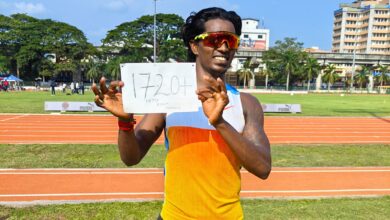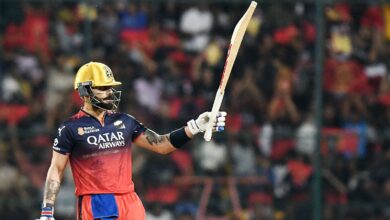Lack of South Asian representation in English football due to lack of ambition, not facilities | Football News

In the Manchester United shellacking of Barnsley in the Carabao Cup, a willowy 18-year-old with dinct South Asian musculature and features stood out. He, Vimal Yoganathan, was no match for the United double pivot of Manuel Ugarte and Casemiro, but in bursts he revealed the intelligence and poise that foretell a promising career at bigger clubs. Yoganathan though has already etched a rare legacy, as the representative of allegedly one of the world’s most oppressed ethnic minorities in the world, the Sri Lankan Tamil community.He was just three years old when Jaffna was besieged. His parents had fled the country long ago and settled in the quaint Welsh town of Trelawnyd. He could have only heard and not experienced the atrocities his parents and relatives might have endured. More than a poignant conflict zone narrative, he has transformed into something bigger, a community’s path-breaker. But his surge also reflects on another theme, the sparse presence of South Asians in British football.
In a recent Sky Sports survey, it came to light that only 22 of the 3,700 professionals in several divisions of English football have South Asian backgrounds. The two familiar names of recent vintage could be Leicester City’s Hamza Choudhury of Bangladeshi-Grenadian heritage and Michael Chopra, the journeyman striker with an Indian father and English mother, who wore the shirts of a dozen clubs including Newcastle United and Cardiff City. Or if you dig back, you stumble on Zesh Rehman, a Fulham defender in the early aughts.
The numbers are starkly different in other sports. Around five percent of professional cricketers have South Asian heritage. It is a low figure, but it is still better than .25 percent. Look elsewhere: among politicians (leader of opposition Rishi Sunak himself), businessmen and dignitaries, South Asians have firmly struck their poles. But not in football.
Vimal Yoganathan for Barnsley FC ( X | Barnsley FC)
Piles of research papers and several reams of newsprint have delved into the near-invisibility of a four-million strong representation. The conclusions have ranged from genetics and diet, to cricket and hockey, to racism, and academic pressure imposed parents. But Yoganathan argues that it could be because they might not be actually interested in playing the sport, as much as they love to watch it.
“I had a friend and we played in the same Sunday League team, but other than that I can’t remember coming up against any South Asian background players,” he told The Guardian.
He was not alone in this opinion. Netan Sansara, who featured in the England U-18 side before relocating to the United States, once said: “I feel like Asian communities do not do enough to show there are Asian professional footballers out in Britain.” Perhaps, they never wanted to integrate themselves into the game for a myriad of reasons, but primarily because they might not feel connected to the sport. The cultural barriers associated with lack of parental consent make it difficult as well. Yoganathan, for instance, stuck to football because he says he had the unconditional support of his parents. Perhaps, all they require is a talismanic figure, the first South Asian superstar to break the barrier.
Lack of endeavour
But the pattern clearly shows that South Asian representation in football is low because they really don’t aspire to be footballers. The sport is vastly consumed but played largely recreationally, despite highly streamlined and systematic pathway projects to ensure that no talent slips through the nets. In the context, this should serve as a message for football officials and footballers who constantly crib about lack of infrastructure and facilities as reasons for India’s stasis in the sport.
Certainly, infrastructure, training and coaching are prerequisites, but in the end, it requires unblemished commitment. Access to state-of-the-art facilities alone can’t produce footballers. Rather it is a cultural thing, where the ambitions plateau at a certain level.
Barnsley’s Vimal Yoganathan a rare representative of community that makes up just 0.25 percent of professional footballers in the country. ( X | @BarnsleyFC)
The early years of Rehman and Chaudhary are excellent case studies on how desire can beat the odds. Rehman played football with friends in parking lots, failed trials at several clubs, didn’t enrol at any grassroots academy but got a chance to play for a Sunday league team, from where Fulham spotted him. Rehman, while admitting of rac taunts, had once told The Guardian that, “We’re living in a multicultural society but maybe, for some, there has been a fear factor in the past about how they would be received at football matches and whether they would be out of their comfort zone. Traditionally, the parents don’t support them.”
South Asian parents are South Asian parents everywhere. They cannot be fully blamed though as sports other than cricket are still not considered career options. In a developing economy, livelihood pressure gets amplified. Yoganathan touched upon this too.
“There’s obviously a lot of contributing factors but I think there’s also that risk and uncertainty about the industry because you can devote your life to it growing up for 15 to 18 years and still might not get a career out of it.” The same rings true in the Indian context.
For the ingrained perceptions and myths to change, a global star from South Asia has to rise. The surge of cricket after the 1983 World Cup triumph is an example. Then the sport shrewdly and diligently consolidated and capitalised on the willow boom. But before such a moment arrives, constantly blaming the infrastructure is just barking up the wrong tree.






